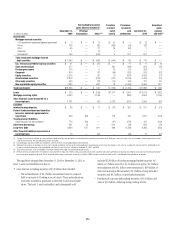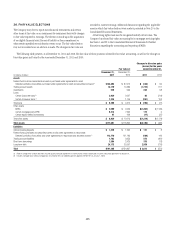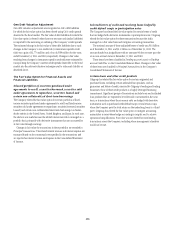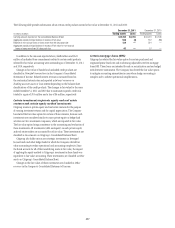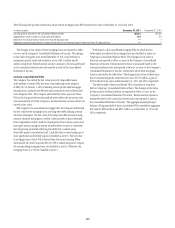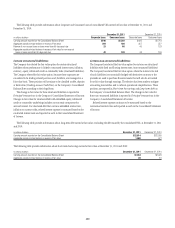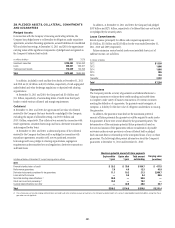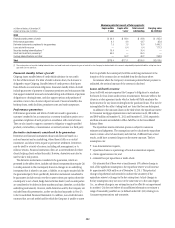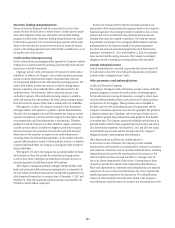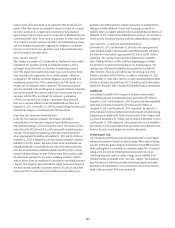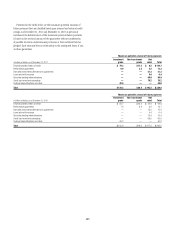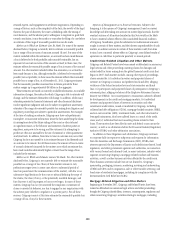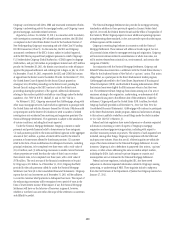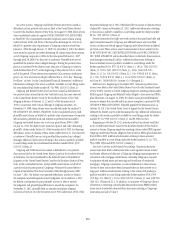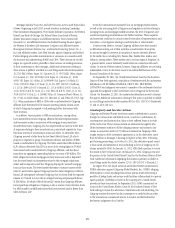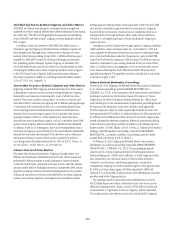Citibank 2011 Annual Report Download - page 284
Download and view the complete annual report
Please find page 284 of the 2011 Citibank annual report below. You can navigate through the pages in the report by either clicking on the pages listed below, or by using the keyword search tool below to find specific information within the annual report.
262
Maximum potential amount of future payments
In billions of dollars at December 31,
except carrying value in millions
Expire within
1 year
Expire after
1 year
Total amount
outstanding
Carrying value
(in millions)
2010
&INANCIALæSTANDBYæLETTERSæOFæCREDIT
0ERFORMANCEæGUARANTEES
$ERIVATIVEæINSTRUMENTSæCONSIDEREDæTOæBEæGUARANTEES
,OANSæSOLDæWITHæRECOURSE
3ECURITIESæLENDINGæINDEMNIFICATIONSæ
#REDITæCARDæMERCHANTæPROCESSINGæ
#USTODYæINDEMNIFICATIONSæANDæOTHER
Total
æ 4HEæCARRYINGæVALUESæOFæSECURITIESæLENDINGæINDEMNIFICATIONSæANDæCREDITæCARDæMERCHANTæPROCESSINGæAREæNOTæMATERIALæASæTHEæ#OMPANYæHASæDETERMINEDæTHATæTHEæAMOUNTæANDæPROBABILITYæOFæPOTENTIALæLIABILITIESæARISINGæFROMæTHESEæ
GUARANTEESæAREæNOTæSIGNIFICANT
Financial standby letters of credit
Citigroup issues standby letters of credit which substitute its own credit
for that of the borrower. If a letter of credit is drawn down, the borrower is
obligated to repay Citigroup. Standby letters of credit protect a third party
from defaults on contractual obligations. Financial standby letters of credit
include guarantees of payment of insurance premiums and reinsurance risks
that support industrial revenue bond underwriting and settlement of payment
obligations to clearing houses, and also support options and purchases of
securities or are in lieu of escrow deposit accounts. Financial standbys also
backstop loans, credit facilities, promissory notes and trade acceptances.
Performance guarantees
Performance guarantees and letters of credit are issued to guarantee a
customer’s tender bid on a construction or systems-installation project or to
guarantee completion of such projects in accordance with contract terms.
They are also issued to support a customer’s obligation to supply specified
products, commodities, or maintenance or warranty services to a third party.
Derivative instruments considered to be guarantees
Derivatives are financial instruments whose cash flows are based on a
notional amount and an underlying, where there is little or no initial
investment, and whose terms require or permit net settlement. Derivatives
may be used for a variety of reasons, including risk management, or to
enhance returns. Financial institutions often act as intermediaries for their
clients, helping clients reduce their risks. However, derivatives may also be
used to take a risk position.
The derivative instruments considered to be guarantees, which are
presented in the tables above, include only those instruments that require Citi
to make payments to the counterparty based on changes in an underlying
instrument that is related to an asset, a liability, or an equity security held by
the guaranteed party. More specifically, derivative instruments considered to
be guarantees include certain over-the-counter written put options where the
counterparty is not a bank, hedge fund or broker-dealer (such counterparties
are considered to be dealers in these markets and may, therefore, not hold the
underlying instruments). However, credit derivatives sold by the Company are
excluded from this presentation, as they are disclosed separately in Note 23
to the Consolidated Financial Statements. In addition, non-credit derivative
contracts that are cash settled and for which the Company is unable to assert
that it is probable the counterparty held the underlying instrument at the
inception of the contract also are excluded from the disclosure above.
In instances where the Company’s maximum potential future payment is
unlimited, the notional amount of the contract is disclosed.
Loans sold with recourse
Loans sold with recourse represent the Company’s obligations to reimburse
the buyers for loan losses under certain circumstances. Recourse refers to the
clause in a sales agreement under which a lender will fully reimburse the
buyer/investor for any losses resulting from the purchased loans. This may be
accomplished by the seller’s taking back any loans that become delinquent.
In addition to the amounts shown in the table above, the repurchase reserve
for Consumer mortgages representations and warranties was $1,188 million
and $969 million at December 31, 2011 and December 31, 2010, respectively,
and these amounts are included in Other liabilities on the Consolidated
Balance Sheet.
The repurchase reserve estimation process is subject to numerous
estimates and judgments. The assumptions used to calculate the repurchase
reserve contain a level of uncertainty and risk that, if different from actual
results, could have a material impact on the reserve amounts. The key
assumptions are:
loan documentation requests;
repurchase claims as a percentage of loan documentation requests;
claims appeal success rate; and
estimated loss per repurchase or make-whole.
Citi estimates that if there were a simultaneous 10% adverse change in
each of the significant assumptions, the repurchase reserve would increase
by approximately $620 million as of December 31, 2011. This potential
change is hypothetical and intended to indicate the sensitivity of the
repurchase reserve to changes in the key assumptions. Actual changes in
the key assumptions may not occur at the same time or to the same degree
(i.e., an adverse change in one assumption may be offset by an improvement
in another). Citi does not believe it has sufficient information to estimate a
range of reasonably possible loss (as defined under ASC 450) relating to its
Consumer representations and warranties.


